Gender Pay Gap at TESCO
VerifiedAdded on 2023/01/17
|9
|2472
|38
AI Summary
This document presents the issue of gender pay gap at TESCO and discusses the strategies and HR practices implemented by the company to reduce this gap. It also highlights the laws and standards followed by TESCO to promote equality and remove discrimination.
Contribute Materials
Your contribution can guide someone’s learning journey. Share your
documents today.

Introduction to Human
Resource Management
Resource Management
Secure Best Marks with AI Grader
Need help grading? Try our AI Grader for instant feedback on your assignments.
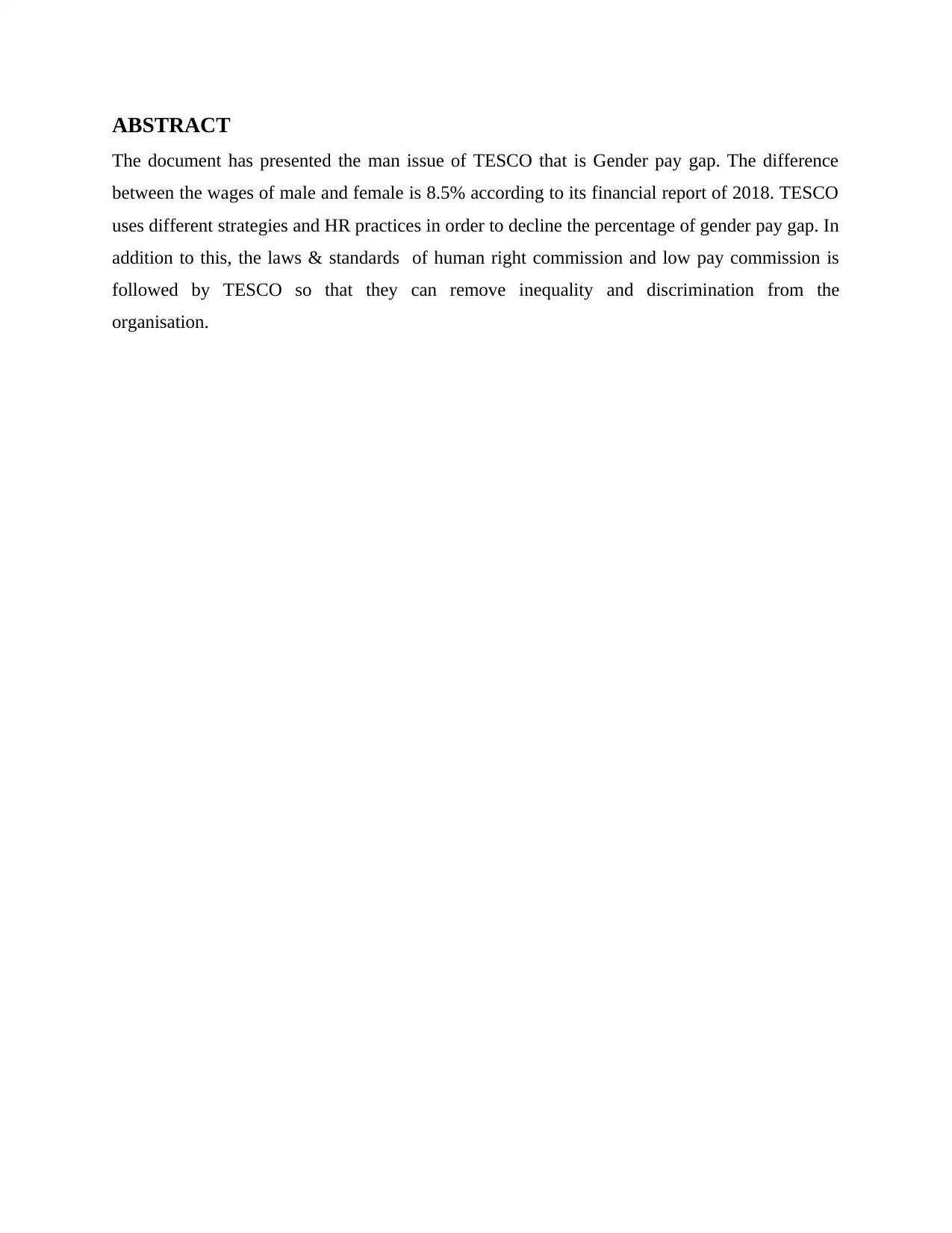
ABSTRACT
The document has presented the man issue of TESCO that is Gender pay gap. The difference
between the wages of male and female is 8.5% according to its financial report of 2018. TESCO
uses different strategies and HR practices in order to decline the percentage of gender pay gap. In
addition to this, the laws & standards of human right commission and low pay commission is
followed by TESCO so that they can remove inequality and discrimination from the
organisation.
The document has presented the man issue of TESCO that is Gender pay gap. The difference
between the wages of male and female is 8.5% according to its financial report of 2018. TESCO
uses different strategies and HR practices in order to decline the percentage of gender pay gap. In
addition to this, the laws & standards of human right commission and low pay commission is
followed by TESCO so that they can remove inequality and discrimination from the
organisation.

Table of Contents
ABSTRACT ....................................................................................................................................2
Introduction .....................................................................................................................................4
About the company .........................................................................................................................4
LITERATURE REVIEW................................................................................................................4
HR Practices ....................................................................................................................................6
CONCLUSION & RECOMMENDATIONS..................................................................................7
RECOMMENDATIONS.......................................................................................................7
CONCLUSION......................................................................................................................8
REFERENCES................................................................................................................................9
Books& journals.....................................................................................................................9
ABSTRACT ....................................................................................................................................2
Introduction .....................................................................................................................................4
About the company .........................................................................................................................4
LITERATURE REVIEW................................................................................................................4
HR Practices ....................................................................................................................................6
CONCLUSION & RECOMMENDATIONS..................................................................................7
RECOMMENDATIONS.......................................................................................................7
CONCLUSION......................................................................................................................8
REFERENCES................................................................................................................................9
Books& journals.....................................................................................................................9
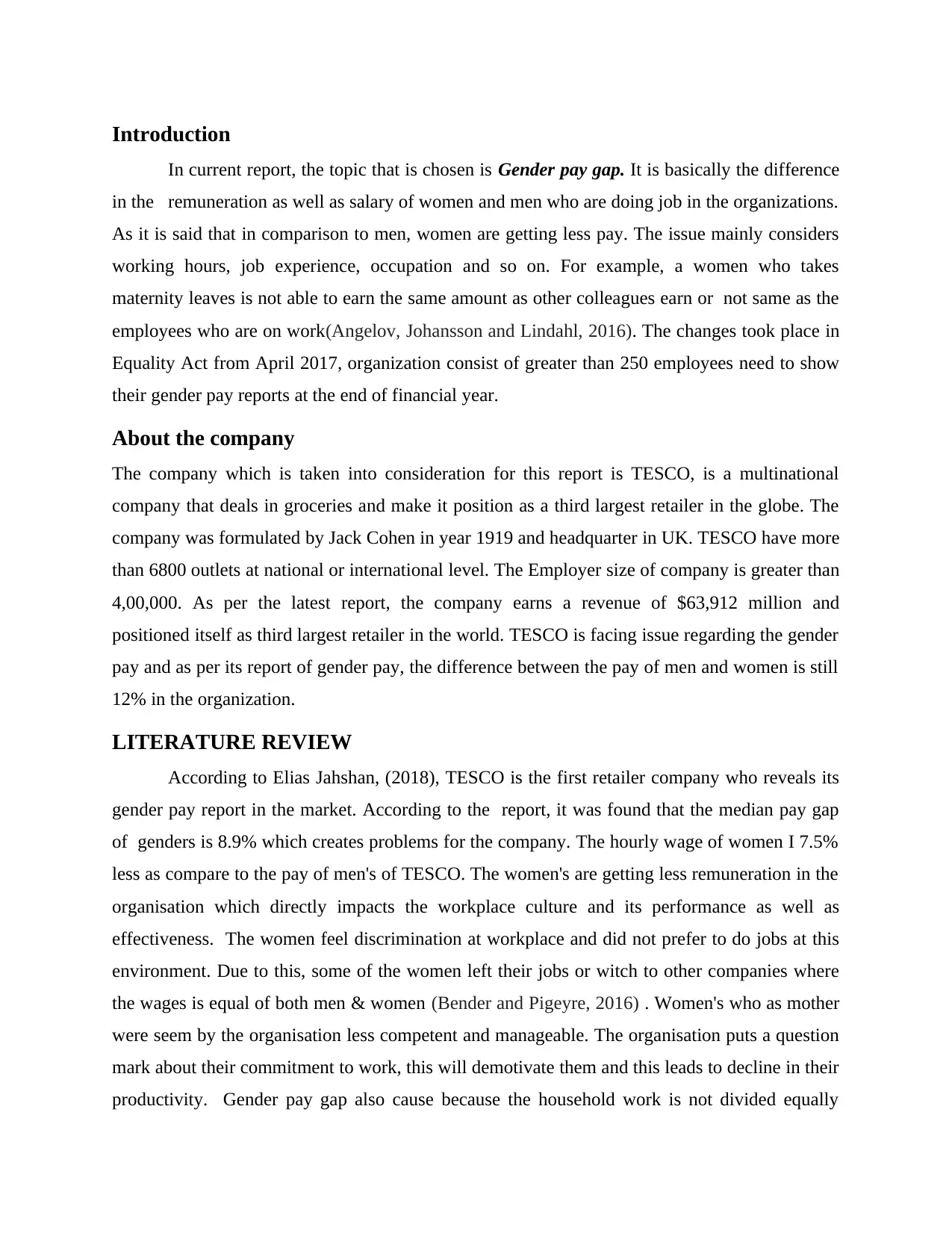
Introduction
In current report, the topic that is chosen is Gender pay gap. It is basically the difference
in the remuneration as well as salary of women and men who are doing job in the organizations.
As it is said that in comparison to men, women are getting less pay. The issue mainly considers
working hours, job experience, occupation and so on. For example, a women who takes
maternity leaves is not able to earn the same amount as other colleagues earn or not same as the
employees who are on work(Angelov, Johansson and Lindahl, 2016). The changes took place in
Equality Act from April 2017, organization consist of greater than 250 employees need to show
their gender pay reports at the end of financial year.
About the company
The company which is taken into consideration for this report is TESCO, is a multinational
company that deals in groceries and make it position as a third largest retailer in the globe. The
company was formulated by Jack Cohen in year 1919 and headquarter in UK. TESCO have more
than 6800 outlets at national or international level. The Employer size of company is greater than
4,00,000. As per the latest report, the company earns a revenue of $63,912 million and
positioned itself as third largest retailer in the world. TESCO is facing issue regarding the gender
pay and as per its report of gender pay, the difference between the pay of men and women is still
12% in the organization.
LITERATURE REVIEW
According to Elias Jahshan, (2018), TESCO is the first retailer company who reveals its
gender pay report in the market. According to the report, it was found that the median pay gap
of genders is 8.9% which creates problems for the company. The hourly wage of women I 7.5%
less as compare to the pay of men's of TESCO. The women's are getting less remuneration in the
organisation which directly impacts the workplace culture and its performance as well as
effectiveness. The women feel discrimination at workplace and did not prefer to do jobs at this
environment. Due to this, some of the women left their jobs or witch to other companies where
the wages is equal of both men & women (Bender and Pigeyre, 2016) . Women's who as mother
were seem by the organisation less competent and manageable. The organisation puts a question
mark about their commitment to work, this will demotivate them and this leads to decline in their
productivity. Gender pay gap also cause because the household work is not divided equally
In current report, the topic that is chosen is Gender pay gap. It is basically the difference
in the remuneration as well as salary of women and men who are doing job in the organizations.
As it is said that in comparison to men, women are getting less pay. The issue mainly considers
working hours, job experience, occupation and so on. For example, a women who takes
maternity leaves is not able to earn the same amount as other colleagues earn or not same as the
employees who are on work(Angelov, Johansson and Lindahl, 2016). The changes took place in
Equality Act from April 2017, organization consist of greater than 250 employees need to show
their gender pay reports at the end of financial year.
About the company
The company which is taken into consideration for this report is TESCO, is a multinational
company that deals in groceries and make it position as a third largest retailer in the globe. The
company was formulated by Jack Cohen in year 1919 and headquarter in UK. TESCO have more
than 6800 outlets at national or international level. The Employer size of company is greater than
4,00,000. As per the latest report, the company earns a revenue of $63,912 million and
positioned itself as third largest retailer in the world. TESCO is facing issue regarding the gender
pay and as per its report of gender pay, the difference between the pay of men and women is still
12% in the organization.
LITERATURE REVIEW
According to Elias Jahshan, (2018), TESCO is the first retailer company who reveals its
gender pay report in the market. According to the report, it was found that the median pay gap
of genders is 8.9% which creates problems for the company. The hourly wage of women I 7.5%
less as compare to the pay of men's of TESCO. The women's are getting less remuneration in the
organisation which directly impacts the workplace culture and its performance as well as
effectiveness. The women feel discrimination at workplace and did not prefer to do jobs at this
environment. Due to this, some of the women left their jobs or witch to other companies where
the wages is equal of both men & women (Bender and Pigeyre, 2016) . Women's who as mother
were seem by the organisation less competent and manageable. The organisation puts a question
mark about their commitment to work, this will demotivate them and this leads to decline in their
productivity. Gender pay gap also cause because the household work is not divided equally
Secure Best Marks with AI Grader
Need help grading? Try our AI Grader for instant feedback on your assignments.
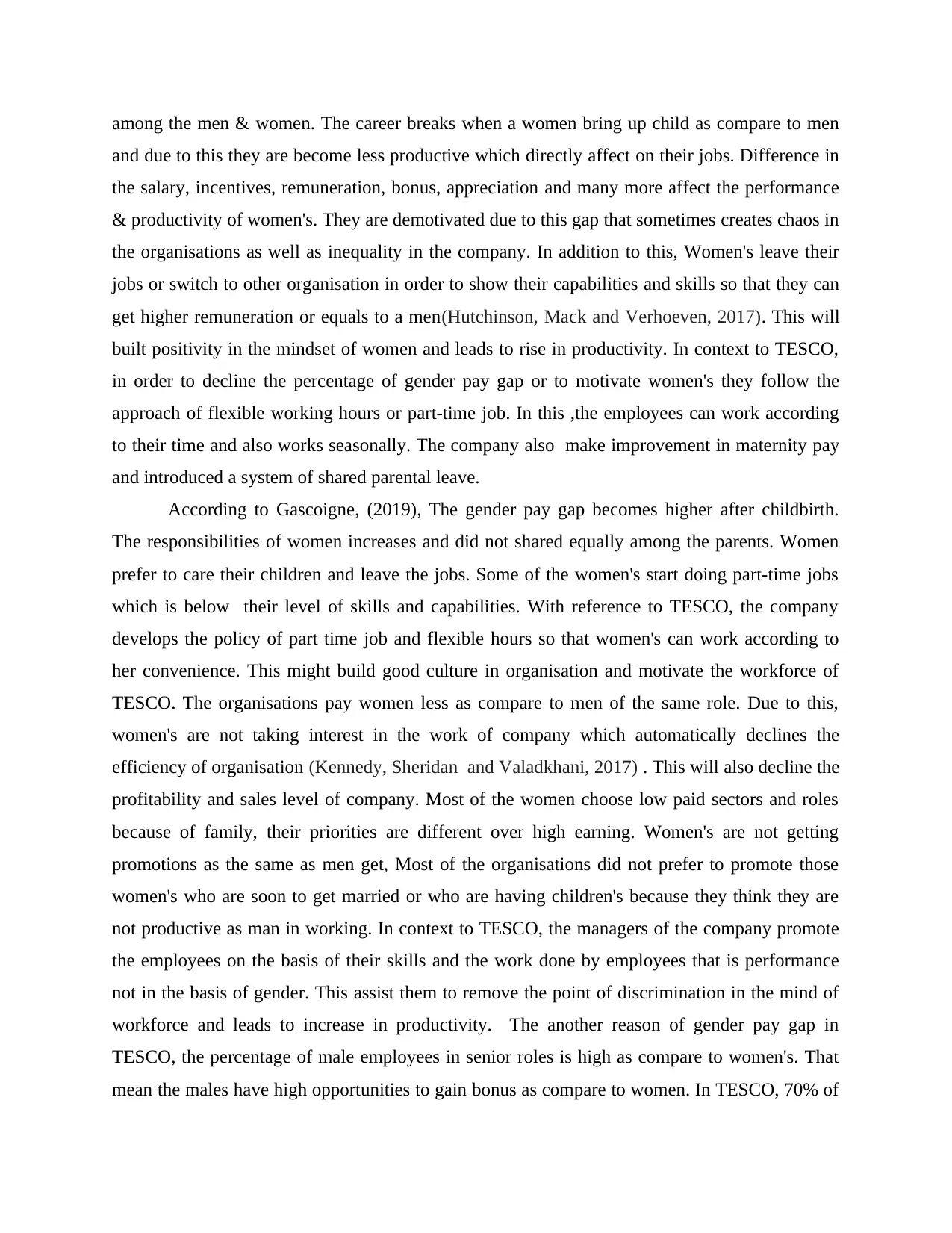
among the men & women. The career breaks when a women bring up child as compare to men
and due to this they are become less productive which directly affect on their jobs. Difference in
the salary, incentives, remuneration, bonus, appreciation and many more affect the performance
& productivity of women's. They are demotivated due to this gap that sometimes creates chaos in
the organisations as well as inequality in the company. In addition to this, Women's leave their
jobs or switch to other organisation in order to show their capabilities and skills so that they can
get higher remuneration or equals to a men(Hutchinson, Mack and Verhoeven, 2017). This will
built positivity in the mindset of women and leads to rise in productivity. In context to TESCO,
in order to decline the percentage of gender pay gap or to motivate women's they follow the
approach of flexible working hours or part-time job. In this ,the employees can work according
to their time and also works seasonally. The company also make improvement in maternity pay
and introduced a system of shared parental leave.
According to Gascoigne, (2019), The gender pay gap becomes higher after childbirth.
The responsibilities of women increases and did not shared equally among the parents. Women
prefer to care their children and leave the jobs. Some of the women's start doing part-time jobs
which is below their level of skills and capabilities. With reference to TESCO, the company
develops the policy of part time job and flexible hours so that women's can work according to
her convenience. This might build good culture in organisation and motivate the workforce of
TESCO. The organisations pay women less as compare to men of the same role. Due to this,
women's are not taking interest in the work of company which automatically declines the
efficiency of organisation (Kennedy, Sheridan and Valadkhani, 2017) . This will also decline the
profitability and sales level of company. Most of the women choose low paid sectors and roles
because of family, their priorities are different over high earning. Women's are not getting
promotions as the same as men get, Most of the organisations did not prefer to promote those
women's who are soon to get married or who are having children's because they think they are
not productive as man in working. In context to TESCO, the managers of the company promote
the employees on the basis of their skills and the work done by employees that is performance
not in the basis of gender. This assist them to remove the point of discrimination in the mind of
workforce and leads to increase in productivity. The another reason of gender pay gap in
TESCO, the percentage of male employees in senior roles is high as compare to women's. That
mean the males have high opportunities to gain bonus as compare to women. In TESCO, 70% of
and due to this they are become less productive which directly affect on their jobs. Difference in
the salary, incentives, remuneration, bonus, appreciation and many more affect the performance
& productivity of women's. They are demotivated due to this gap that sometimes creates chaos in
the organisations as well as inequality in the company. In addition to this, Women's leave their
jobs or switch to other organisation in order to show their capabilities and skills so that they can
get higher remuneration or equals to a men(Hutchinson, Mack and Verhoeven, 2017). This will
built positivity in the mindset of women and leads to rise in productivity. In context to TESCO,
in order to decline the percentage of gender pay gap or to motivate women's they follow the
approach of flexible working hours or part-time job. In this ,the employees can work according
to their time and also works seasonally. The company also make improvement in maternity pay
and introduced a system of shared parental leave.
According to Gascoigne, (2019), The gender pay gap becomes higher after childbirth.
The responsibilities of women increases and did not shared equally among the parents. Women
prefer to care their children and leave the jobs. Some of the women's start doing part-time jobs
which is below their level of skills and capabilities. With reference to TESCO, the company
develops the policy of part time job and flexible hours so that women's can work according to
her convenience. This might build good culture in organisation and motivate the workforce of
TESCO. The organisations pay women less as compare to men of the same role. Due to this,
women's are not taking interest in the work of company which automatically declines the
efficiency of organisation (Kennedy, Sheridan and Valadkhani, 2017) . This will also decline the
profitability and sales level of company. Most of the women choose low paid sectors and roles
because of family, their priorities are different over high earning. Women's are not getting
promotions as the same as men get, Most of the organisations did not prefer to promote those
women's who are soon to get married or who are having children's because they think they are
not productive as man in working. In context to TESCO, the managers of the company promote
the employees on the basis of their skills and the work done by employees that is performance
not in the basis of gender. This assist them to remove the point of discrimination in the mind of
workforce and leads to increase in productivity. The another reason of gender pay gap in
TESCO, the percentage of male employees in senior roles is high as compare to women's. That
mean the males have high opportunities to gain bonus as compare to women. In TESCO, 70% of
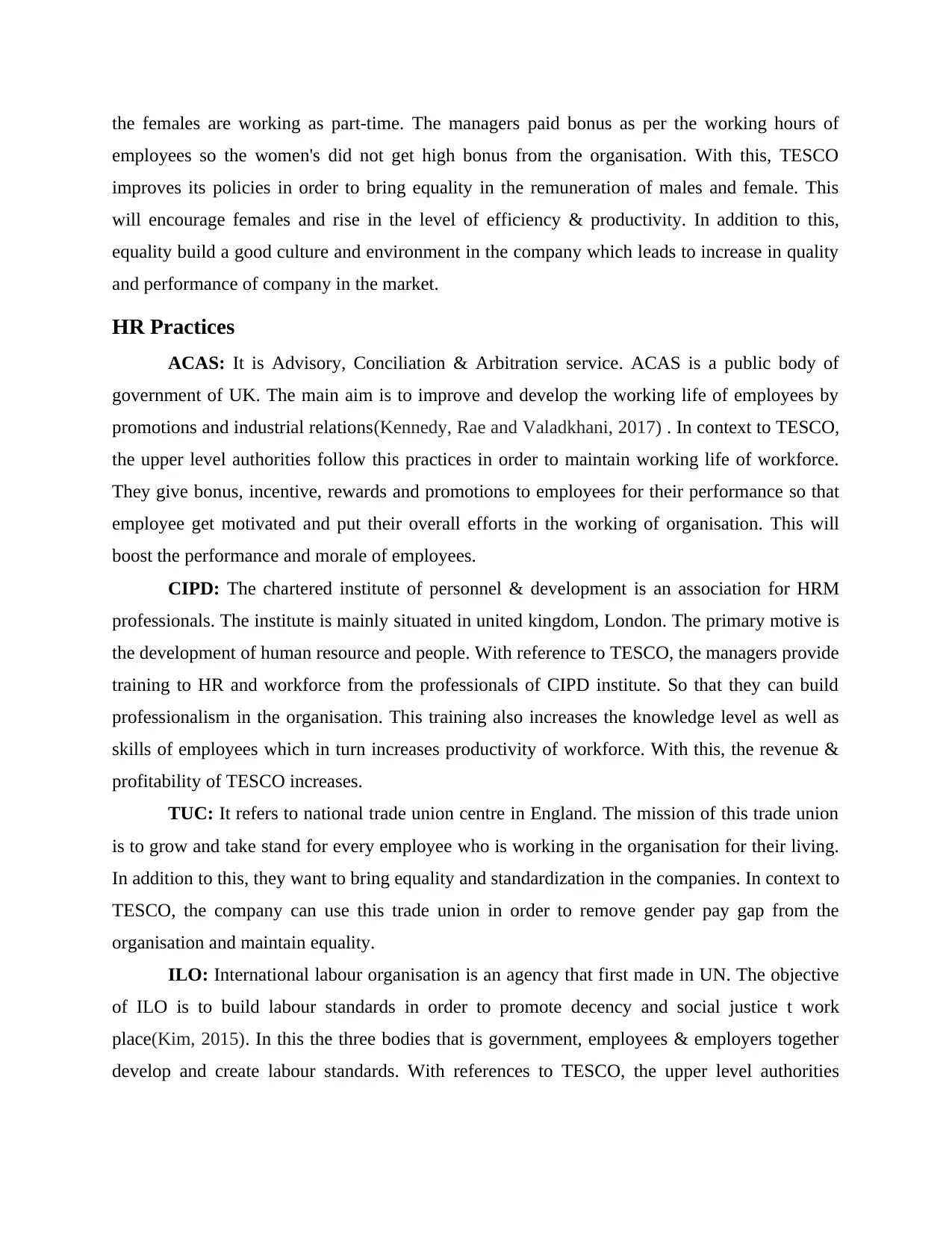
the females are working as part-time. The managers paid bonus as per the working hours of
employees so the women's did not get high bonus from the organisation. With this, TESCO
improves its policies in order to bring equality in the remuneration of males and female. This
will encourage females and rise in the level of efficiency & productivity. In addition to this,
equality build a good culture and environment in the company which leads to increase in quality
and performance of company in the market.
HR Practices
ACAS: It is Advisory, Conciliation & Arbitration service. ACAS is a public body of
government of UK. The main aim is to improve and develop the working life of employees by
promotions and industrial relations(Kennedy, Rae and Valadkhani, 2017) . In context to TESCO,
the upper level authorities follow this practices in order to maintain working life of workforce.
They give bonus, incentive, rewards and promotions to employees for their performance so that
employee get motivated and put their overall efforts in the working of organisation. This will
boost the performance and morale of employees.
CIPD: The chartered institute of personnel & development is an association for HRM
professionals. The institute is mainly situated in united kingdom, London. The primary motive is
the development of human resource and people. With reference to TESCO, the managers provide
training to HR and workforce from the professionals of CIPD institute. So that they can build
professionalism in the organisation. This training also increases the knowledge level as well as
skills of employees which in turn increases productivity of workforce. With this, the revenue &
profitability of TESCO increases.
TUC: It refers to national trade union centre in England. The mission of this trade union
is to grow and take stand for every employee who is working in the organisation for their living.
In addition to this, they want to bring equality and standardization in the companies. In context to
TESCO, the company can use this trade union in order to remove gender pay gap from the
organisation and maintain equality.
ILO: International labour organisation is an agency that first made in UN. The objective
of ILO is to build labour standards in order to promote decency and social justice t work
place(Kim, 2015). In this the three bodies that is government, employees & employers together
develop and create labour standards. With references to TESCO, the upper level authorities
employees so the women's did not get high bonus from the organisation. With this, TESCO
improves its policies in order to bring equality in the remuneration of males and female. This
will encourage females and rise in the level of efficiency & productivity. In addition to this,
equality build a good culture and environment in the company which leads to increase in quality
and performance of company in the market.
HR Practices
ACAS: It is Advisory, Conciliation & Arbitration service. ACAS is a public body of
government of UK. The main aim is to improve and develop the working life of employees by
promotions and industrial relations(Kennedy, Rae and Valadkhani, 2017) . In context to TESCO,
the upper level authorities follow this practices in order to maintain working life of workforce.
They give bonus, incentive, rewards and promotions to employees for their performance so that
employee get motivated and put their overall efforts in the working of organisation. This will
boost the performance and morale of employees.
CIPD: The chartered institute of personnel & development is an association for HRM
professionals. The institute is mainly situated in united kingdom, London. The primary motive is
the development of human resource and people. With reference to TESCO, the managers provide
training to HR and workforce from the professionals of CIPD institute. So that they can build
professionalism in the organisation. This training also increases the knowledge level as well as
skills of employees which in turn increases productivity of workforce. With this, the revenue &
profitability of TESCO increases.
TUC: It refers to national trade union centre in England. The mission of this trade union
is to grow and take stand for every employee who is working in the organisation for their living.
In addition to this, they want to bring equality and standardization in the companies. In context to
TESCO, the company can use this trade union in order to remove gender pay gap from the
organisation and maintain equality.
ILO: International labour organisation is an agency that first made in UN. The objective
of ILO is to build labour standards in order to promote decency and social justice t work
place(Kim, 2015). In this the three bodies that is government, employees & employers together
develop and create labour standards. With references to TESCO, the upper level authorities
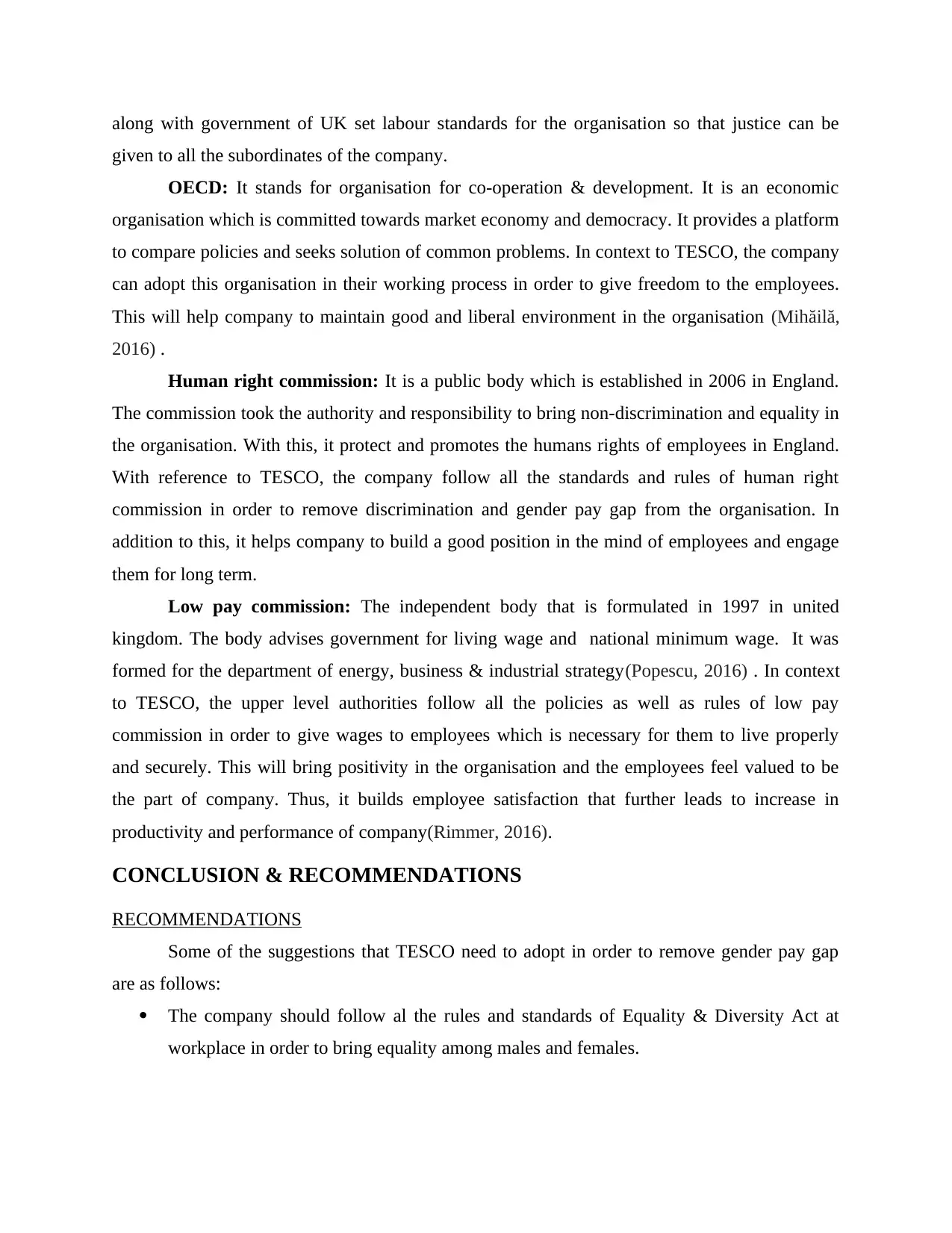
along with government of UK set labour standards for the organisation so that justice can be
given to all the subordinates of the company.
OECD: It stands for organisation for co-operation & development. It is an economic
organisation which is committed towards market economy and democracy. It provides a platform
to compare policies and seeks solution of common problems. In context to TESCO, the company
can adopt this organisation in their working process in order to give freedom to the employees.
This will help company to maintain good and liberal environment in the organisation (Mihăilă,
2016) .
Human right commission: It is a public body which is established in 2006 in England.
The commission took the authority and responsibility to bring non-discrimination and equality in
the organisation. With this, it protect and promotes the humans rights of employees in England.
With reference to TESCO, the company follow all the standards and rules of human right
commission in order to remove discrimination and gender pay gap from the organisation. In
addition to this, it helps company to build a good position in the mind of employees and engage
them for long term.
Low pay commission: The independent body that is formulated in 1997 in united
kingdom. The body advises government for living wage and national minimum wage. It was
formed for the department of energy, business & industrial strategy(Popescu, 2016) . In context
to TESCO, the upper level authorities follow all the policies as well as rules of low pay
commission in order to give wages to employees which is necessary for them to live properly
and securely. This will bring positivity in the organisation and the employees feel valued to be
the part of company. Thus, it builds employee satisfaction that further leads to increase in
productivity and performance of company(Rimmer, 2016).
CONCLUSION & RECOMMENDATIONS
RECOMMENDATIONS
Some of the suggestions that TESCO need to adopt in order to remove gender pay gap
are as follows:
The company should follow al the rules and standards of Equality & Diversity Act at
workplace in order to bring equality among males and females.
given to all the subordinates of the company.
OECD: It stands for organisation for co-operation & development. It is an economic
organisation which is committed towards market economy and democracy. It provides a platform
to compare policies and seeks solution of common problems. In context to TESCO, the company
can adopt this organisation in their working process in order to give freedom to the employees.
This will help company to maintain good and liberal environment in the organisation (Mihăilă,
2016) .
Human right commission: It is a public body which is established in 2006 in England.
The commission took the authority and responsibility to bring non-discrimination and equality in
the organisation. With this, it protect and promotes the humans rights of employees in England.
With reference to TESCO, the company follow all the standards and rules of human right
commission in order to remove discrimination and gender pay gap from the organisation. In
addition to this, it helps company to build a good position in the mind of employees and engage
them for long term.
Low pay commission: The independent body that is formulated in 1997 in united
kingdom. The body advises government for living wage and national minimum wage. It was
formed for the department of energy, business & industrial strategy(Popescu, 2016) . In context
to TESCO, the upper level authorities follow all the policies as well as rules of low pay
commission in order to give wages to employees which is necessary for them to live properly
and securely. This will bring positivity in the organisation and the employees feel valued to be
the part of company. Thus, it builds employee satisfaction that further leads to increase in
productivity and performance of company(Rimmer, 2016).
CONCLUSION & RECOMMENDATIONS
RECOMMENDATIONS
Some of the suggestions that TESCO need to adopt in order to remove gender pay gap
are as follows:
The company should follow al the rules and standards of Equality & Diversity Act at
workplace in order to bring equality among males and females.
Paraphrase This Document
Need a fresh take? Get an instant paraphrase of this document with our AI Paraphraser
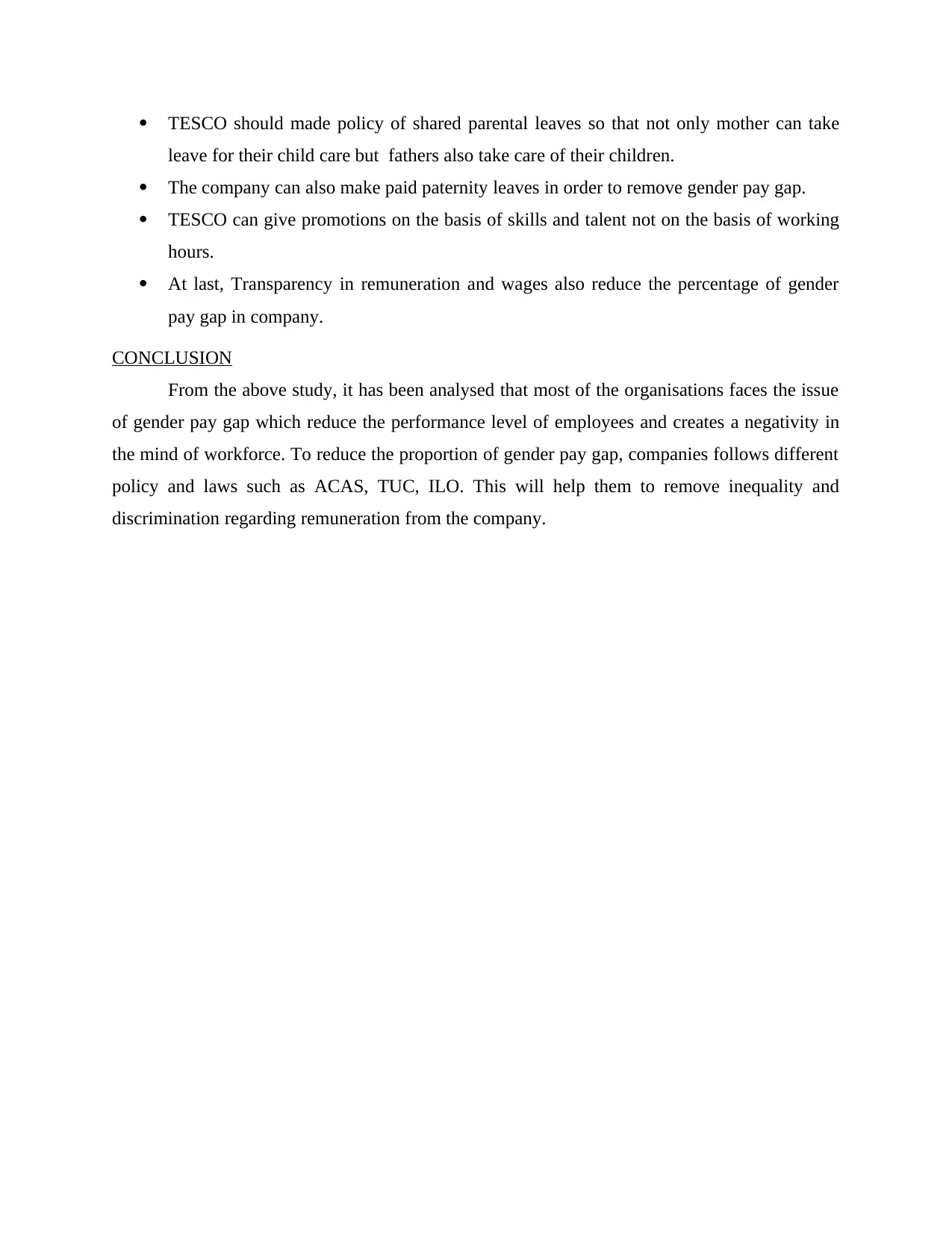
TESCO should made policy of shared parental leaves so that not only mother can take
leave for their child care but fathers also take care of their children.
The company can also make paid paternity leaves in order to remove gender pay gap.
TESCO can give promotions on the basis of skills and talent not on the basis of working
hours.
At last, Transparency in remuneration and wages also reduce the percentage of gender
pay gap in company.
CONCLUSION
From the above study, it has been analysed that most of the organisations faces the issue
of gender pay gap which reduce the performance level of employees and creates a negativity in
the mind of workforce. To reduce the proportion of gender pay gap, companies follows different
policy and laws such as ACAS, TUC, ILO. This will help them to remove inequality and
discrimination regarding remuneration from the company.
leave for their child care but fathers also take care of their children.
The company can also make paid paternity leaves in order to remove gender pay gap.
TESCO can give promotions on the basis of skills and talent not on the basis of working
hours.
At last, Transparency in remuneration and wages also reduce the percentage of gender
pay gap in company.
CONCLUSION
From the above study, it has been analysed that most of the organisations faces the issue
of gender pay gap which reduce the performance level of employees and creates a negativity in
the mind of workforce. To reduce the proportion of gender pay gap, companies follows different
policy and laws such as ACAS, TUC, ILO. This will help them to remove inequality and
discrimination regarding remuneration from the company.
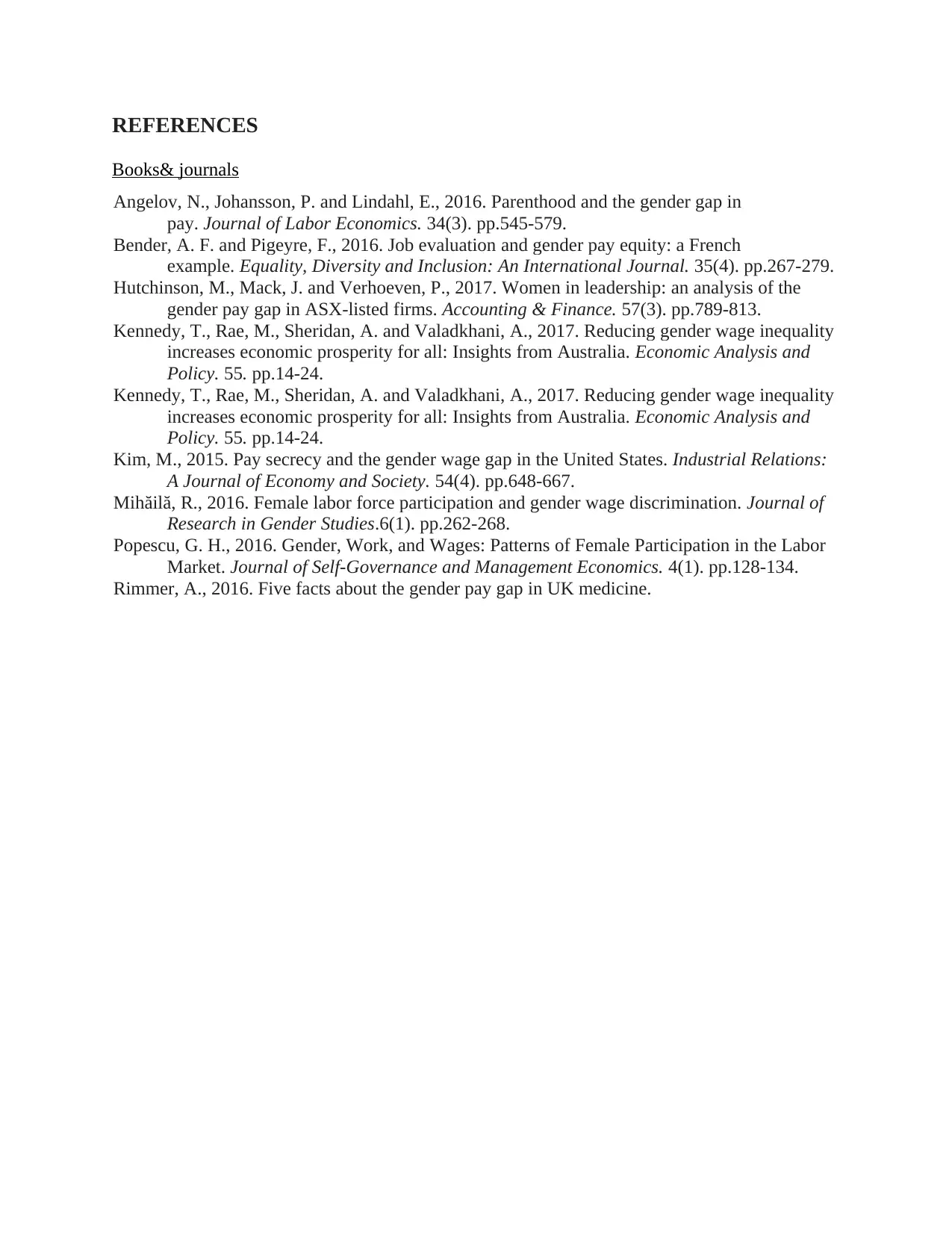
REFERENCES
Books& journals
Angelov, N., Johansson, P. and Lindahl, E., 2016. Parenthood and the gender gap in
pay. Journal of Labor Economics. 34(3). pp.545-579.
Bender, A. F. and Pigeyre, F., 2016. Job evaluation and gender pay equity: a French
example. Equality, Diversity and Inclusion: An International Journal. 35(4). pp.267-279.
Hutchinson, M., Mack, J. and Verhoeven, P., 2017. Women in leadership: an analysis of the
gender pay gap in ASX‐listed firms. Accounting & Finance. 57(3). pp.789-813.
Kennedy, T., Rae, M., Sheridan, A. and Valadkhani, A., 2017. Reducing gender wage inequality
increases economic prosperity for all: Insights from Australia. Economic Analysis and
Policy. 55. pp.14-24.
Kennedy, T., Rae, M., Sheridan, A. and Valadkhani, A., 2017. Reducing gender wage inequality
increases economic prosperity for all: Insights from Australia. Economic Analysis and
Policy. 55. pp.14-24.
Kim, M., 2015. Pay secrecy and the gender wage gap in the United States. Industrial Relations:
A Journal of Economy and Society. 54(4). pp.648-667.
Mihăilă, R., 2016. Female labor force participation and gender wage discrimination. Journal of
Research in Gender Studies.6(1). pp.262-268.
Popescu, G. H., 2016. Gender, Work, and Wages: Patterns of Female Participation in the Labor
Market. Journal of Self-Governance and Management Economics. 4(1). pp.128-134.
Rimmer, A., 2016. Five facts about the gender pay gap in UK medicine.
Books& journals
Angelov, N., Johansson, P. and Lindahl, E., 2016. Parenthood and the gender gap in
pay. Journal of Labor Economics. 34(3). pp.545-579.
Bender, A. F. and Pigeyre, F., 2016. Job evaluation and gender pay equity: a French
example. Equality, Diversity and Inclusion: An International Journal. 35(4). pp.267-279.
Hutchinson, M., Mack, J. and Verhoeven, P., 2017. Women in leadership: an analysis of the
gender pay gap in ASX‐listed firms. Accounting & Finance. 57(3). pp.789-813.
Kennedy, T., Rae, M., Sheridan, A. and Valadkhani, A., 2017. Reducing gender wage inequality
increases economic prosperity for all: Insights from Australia. Economic Analysis and
Policy. 55. pp.14-24.
Kennedy, T., Rae, M., Sheridan, A. and Valadkhani, A., 2017. Reducing gender wage inequality
increases economic prosperity for all: Insights from Australia. Economic Analysis and
Policy. 55. pp.14-24.
Kim, M., 2015. Pay secrecy and the gender wage gap in the United States. Industrial Relations:
A Journal of Economy and Society. 54(4). pp.648-667.
Mihăilă, R., 2016. Female labor force participation and gender wage discrimination. Journal of
Research in Gender Studies.6(1). pp.262-268.
Popescu, G. H., 2016. Gender, Work, and Wages: Patterns of Female Participation in the Labor
Market. Journal of Self-Governance and Management Economics. 4(1). pp.128-134.
Rimmer, A., 2016. Five facts about the gender pay gap in UK medicine.
1 out of 9
Related Documents
Your All-in-One AI-Powered Toolkit for Academic Success.
+13062052269
info@desklib.com
Available 24*7 on WhatsApp / Email
![[object Object]](/_next/static/media/star-bottom.7253800d.svg)
Unlock your academic potential
© 2024 | Zucol Services PVT LTD | All rights reserved.




